
Personal branding for business leaders – All you need to know
Why should you pursue a personal branding strategy? When is the best time to begin and who should be involved?
You’re about to step into the new world of personal branding for business leaders…
A recent study conducted by Harvard and the Edelman Trust Institute has proven customer expectations are evolving to include leadership in personal branding topics. People aren’t looking to buy from the most competitive monopoly anymore. What they’re wanting is a good brand: good in quality, environmentalism, social standings, and PR with real people at the front of it all, cultivating real trust with customers. However, leading and delegating within a business is one thing – building a personal branding strategy is a whole beast of its own.
Table of Contents
- Why is personal branding important for your company
- Who should be part of a personal branding strategy and when
- Audiences to whom your executives might speak
- How to design an executive branding strategy for LinkedIn
- How to create personal branding on LinkedIn that matches your SEO
- A client success story – executive profiling at EC-PR
Why is personal branding important for your company
Personal branding helps your company more than you realise, or did you think brand awareness came from advertising? In branding your business, or brand profiling, a company focuses on establishing its values, customer promises, culture and basic behaviours that the business and its employees are expected to uphold. It’s the blueprint that gives your brand an identity.
Brand profiling establishes the kind of relationship your company has with its clients and how it presents itself to future prospects. For example, EC-PR shows its bold, energetic brand profile through its bright colours, LinkedIn posts, thought leadership, and even through the tone of voice in this article. We make what we stand for and how we do things obvious, so there’s no confusion when it comes to our clients knowing who we are.
But that’s business branding. When it comes to personal branding, clients want to see support for a company coming from the inside, without relying on outdated ad campaigns, a spokesperson figurehead, or the sometimes-flimsy quid-pro-quo of an influencer’s sponsorship for monetary compensation.
Not only that, but personal branding keeps the connection between your business and its clients at a human level.
In a nutshell: people buy from people. Your ideal clients aren’t being sold on your company by the company, but by the person (or people) behind it, which is where executive profiling enters the playing field. As you’ve probably guessed by now, executive profiling is personal branding using your company’s leadership.
Human Connection > Corporate Entity
Benefits of clear personal branding for profits and branding
Personal branding is centred around crafting and promoting a distinct identity that sets leaders apart, emphasising their unique value and expertise in their field. When you have clarity in your executive profiling, your leadership stands out as a true experts in their field and in your company, which strengthens credibility and builds gravitas. This brings your company:
- Recognition and authority
- Visibility on a human-to-human level
- Customer relatability and higher retention
Which accumulates to more lucrative opportunities with higher paying clientele, and more intimately positions your company as a well-versed competitor within its niche.
Pitfalls when personal branding or executive profiling has been rushed
You still need a strategy for executive profiling. Jumping into executive profiling without using good personal branding tips or following a proven step-by-step process to brand success won’t achieve anything other than showing your company is misaligned, confused, and not ready to be taken seriously.
Take this into account when you try attaching other strategies to your personal brand for increased organic traffic, PR communications, or even SEO. What happens when your CEO doesn’t come across as strategic and mindful or as a risk-taking visionary with the proof to back them up? You get Elon Musk blocking memes about himself on Twitter and nothing about Tesla on your feed.
What happens if you wait too long to strategise your executives’ branding?

On the contrary, waiting too long to strategise can make your company look goofy and risks you losing the chance to foster an authentic relationship with your clients and prospects.
Here’s a statistic: Edelman revealed that a whopping 82% of people are more likely to trust a company when their senior executives are active on social media. LinkedIn states that leads developed through employee social marketing convert more frequently than others and socially engaged companies are 57% more likely to see increased sales leads.
A company without personal branding for their C-Suite means those numbers disappear. If you want your brand to stop being a cub in the PR jungle, then it’d be foolish to ignore what works and not promote executive profiling as part of your personal branding strategy.
2Who should be part of a personal branding strategy and when
Like any other strategy, your personal branding strategy needs a team to get started. Personal branding relies heavily on conceptualisation before initiating anything tangible.
When considering whether to enlist your executive profiling service for a senior leader who is not the CEO of your organisation, remember this: Influence doesn’t have to be confined to the captain steering the ship. Elevating the online presence of your senior executives, not just your CEO, is a strategic move in today’s interconnected business landscape and allows you to tap into more SEO clusters.
Each leader brings unique perspectives, expertise, and industry insights that can powerfully augment your company’s profile. Embrace the collective potential of your leadership team, and you’ll discover that executive profiling isn’t limited by titles; it’s driven by the value they bring to your brand. While you deliberate on who to include, consider…
- Which people have the expertise to build your team for a personal branding strategy?
Who in your marketing team can help build the strategy? Should you include people from across departments to brainstorm on what adjectives set a profile that aligns with your business brand? Maybe you’ll need a campaign champion to convince your board of execs for approval, so you’ll want a separate person in leadership involved. Maybe you want a consultant to handle the heavy lifting and steer your company in the right direction. - What leadership position would be a good fit to communicate with your audience on a personal level?
Which roles are more relevant for your clients to hear from? Would it be the CMO of your business in PR or the CTO of your tech company? It may be more than one individual in leadership who should hone in on personal branding. We suggest including any executive with a position that is highly related to what your company does, including the Chief Technology or Innovation Officers. Hearing insider secrets, employee knowledge, and excitement for the newest launches is advantageous; when it comes from a person who’s responsible for that new launch, it’s even better. - What online communities do you want to focus on? Social media has no bounds for executive profiling. But in the B2B landscape it is likely that developing your C-suite’s personal brand on LinkedIn will be critical to reaching your prospects, customers and partners.
3Audiences to whom your executives might speak
Let’s dive deeper into executive profiling: who can your leadership team speak to in their personal branding? As with any branding strategy, personal branding can be marketed to a variety of audiences depending on your goals.
Being present and engaging with others is the first crucial step to your own posts landing well. Experts, such as Lea Turner, Director of Lea Does LinkedIn recommend posting daily to see results.
“If you want to build visibility, you really need to be active, posting content at least twice a week. Obviously, more is better. Between two to five posts a week is what I recommend.”
Pass this advice onto executives so they “warm up” their own personal network prior to talking about company updates, launches, or news.
Personal branding for your investor update spokesperson
One way to elevate your leadership’s personal branding and gravitas is by having them perform as an active spokesperson for investment updates. One use case is giving the quarterly report as one of their LinkedIn posts. What better way to show how sharp your fangs are than by making it accessible via the internet?
Having your leadership share metrics and data that investors use to consider whether they’ll risk adding your company to their portfolio also opens the door to investor inquiry. An in-house expert, with whom investors can watch and interact with, entices business relationships with your brand
Personal branding for partner communications
Along the same vein, having leadership manage a personal brand with direct ties to your company cultivates partnerships. Through executive profiling, prospects receive transparency, regular updates, and open dialogue. This is a spectacular way to detail services, promote tools and insights, and illustrate case studies upfront and without making partners search through your website.
Personal branding for your customer-centric spokesperson
Regardless of the audience, personal branding will always boost PR between you and your clients. In the age of the internet, where socials continue to expand and blur the lines between personal and professional, customers yearn for a human connection not only with their friends and family, but also with the companies they choose to support.
Executive profiling doesn’t just give credibility to brand experts in your company, it also garners a reputation as a people-centric environment, wanting to create lasting and sustainable relationships between the people in the business and its target audience. This leads to a memorable brand identity with a customer experience based on equity and an emotional investment.
4How to design an executive branding strategy for LinkedIn
Now to the nitty-gritty. Remember when we said you should consider which online communities to focus on? We lied. Not every site is built the same, and some really don’t care about your quarterly reports, company news, or water cooler talk on the weekend. So, how do you create a personal branding strategy? Start with personal branding on LinkedIn; the site that’s now pioneering the evolution of executive branding.
You can break down branding strategy into three levels: early stage, scale-up, and corporate.
Early stage
Start by narrowing down your target audience. Knowing who exactly your leadership wants to speak to will help you later understand what will best fit their brand and help you plan your content strategy. Note the purpose of your personal brand, what characteristics best represent your company’s mission and goals, and what types of content output to focus on.
Scale-up
Once you’ve finished brainstorming, it’s time to leverage your executive platform. Start posting on LinkedIn and build your network. Don’t be shy to send your first connection request. It’s better to put your platform in motion instead of waiting for a reaction from an audience pool you haven’t attracted, yet. DMs leave an immediate impression on the other person. Just remember, they’re not for pitch-slapping a cold call-text to a stranger – they’re for introductions to real connections.
Short-form memos, personal anecdotes, company how-tos, and even selfies garner momentum to scale up your personal brand. If you’re not too shy, create videos where you discuss current events in your company’s niche. Videos, especially ones with minor editing, give off the most organic feeling and act as a highlight of the human behind the corporate curtain.
Corporate
Evaluate results on a regular basis or when you feel like you’re gaining traction. LinkedIn offers stats and insights within its own site for your account, making it easy to study your content for statistics on impressions, engagement, and how quickly your network is growing.
5How to create personal branding on LinkedIn that matches your SEO
It’s finally time to talk about the elephant in the room. With your personal brand created and your LinkedIn profile optimised, how do you use it to convert to SEO traffic? In regular SEO branding, your company creates a household name which eventually teaches search engines to identify keywords associated with your business. The more recognition your branding has, the higher your company’s site is positioned at the top of a search feed. Adidas is Adidas, Coach is Coach, and when you search for them in Google, Google knows exactly which site to show you first.
What does this mean for executive profiling? The more personal branding awareness your leadership has, the more brand awareness your business has.
With personal branding maximised, you can funnel your target market through your leadership team, to their business (which they talk about all the time), and steer client attention to your company site organically. As they educate themselves on your corporate platforms and read up on featured blogs and industry outlets, search engines will be trained to push your business to the top of the feed. Eventually, you have a web of branding interconnected between multiple SEO clusters.
6Executive profiling at EC-PR
Since any company worth its salt should operate by example, here’s a case study we did at EC-PR.
In just 28 days, we saw three prospects request meetings with this Senior Sales Director and:
- increased their reach (impressions) by 1,698,400% (from just 1 impression over the previous month to 16,895 impressions)
- saw a 31,600% increase in Likes, Comments, and Shares (from 0 to 317)
- and a 16,700% increase in his followers (a total of 168 new followers as part of a targeted approach)

These results are a testament to the power of our Catalyst executive profiling service. We use a combination of strategic content creation including SEO through our Catalyst workshop, targeted connection requests, and ongoing insights and knowledge of the ever-changing LinkedIn algorithm to help our clients build a dynamic and impactful presence on LinkedIn.
Through Catalyst, we provide a step-by-step process to curating a successful personal brand that bridges the gap between target markets and your company, whilst using SEO algorithms to your advantage.
10 reasons your CEO 'shouldn't' be on LinkedIn
Watch our experts overcome all the objections in our on-demand webinar.
Plus download our free fast-track guide to LinkedIn.

Discover how we use LinkedIn to grow influence
Our proven, white glove approach to building senior executive reach and influence on LinkedIn.

Fast-track guide to LinkedIn for Leaders

8 ways to optimise your LinkedIn for thought leadership, engagement and brand growth


